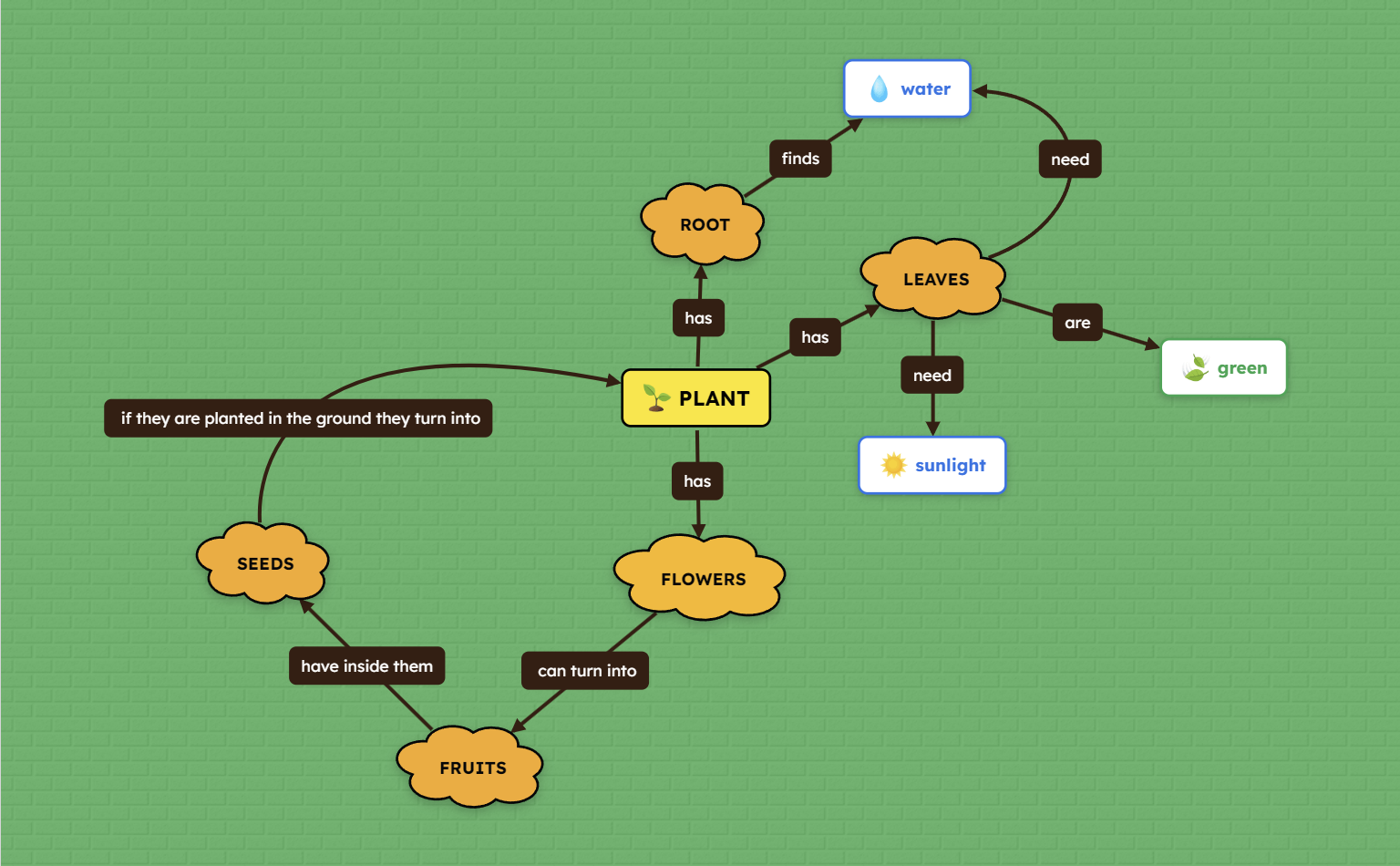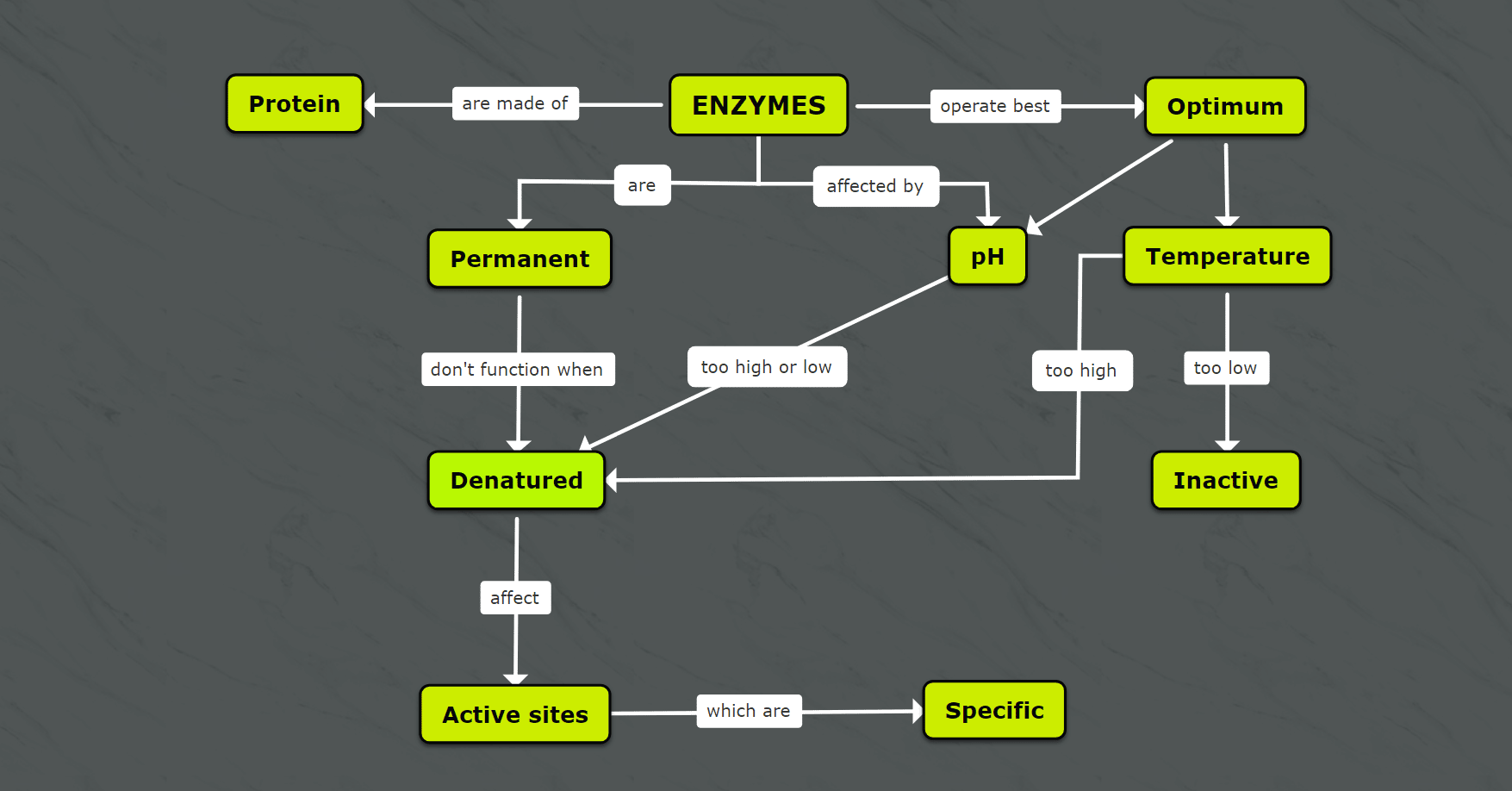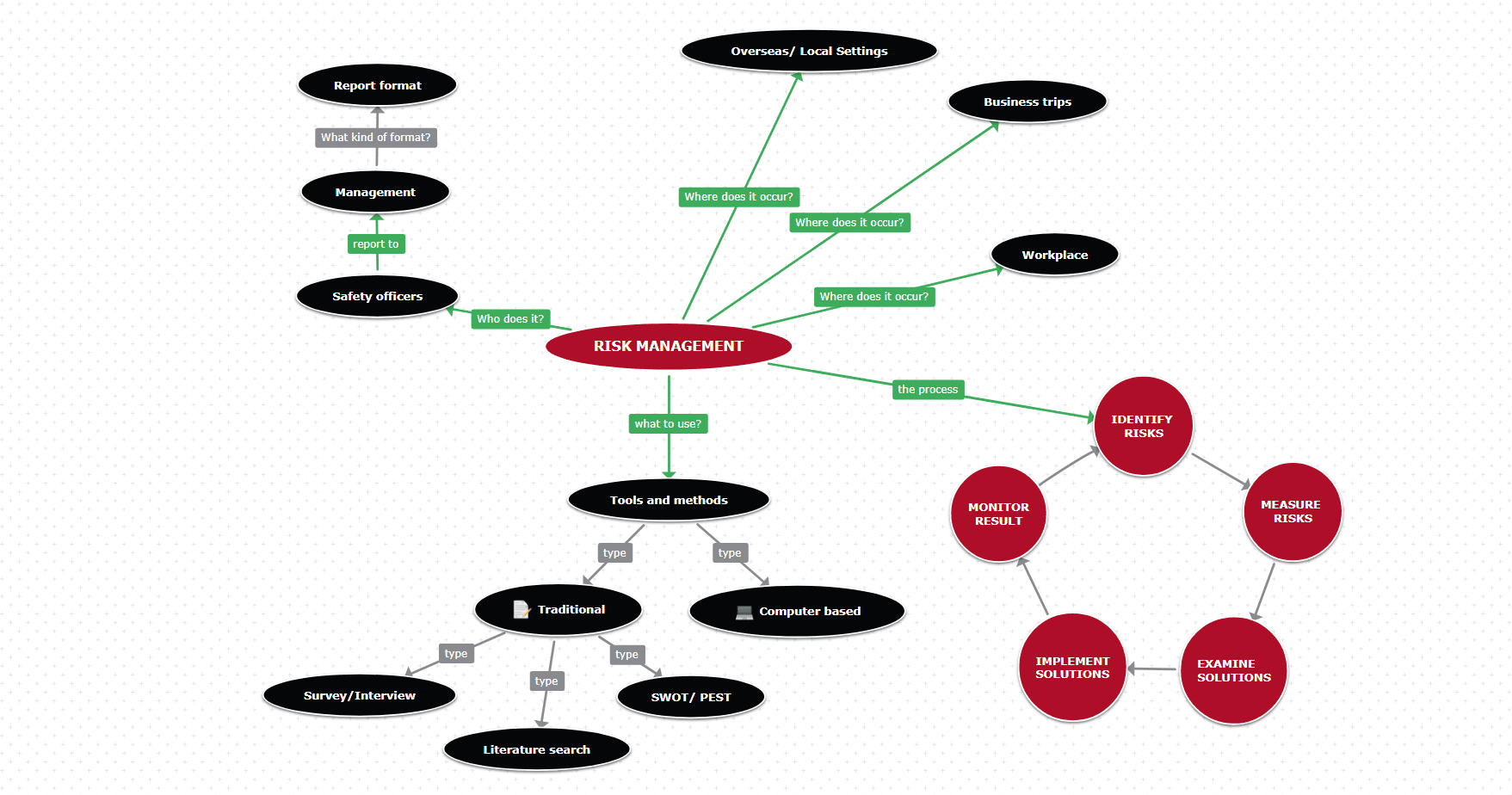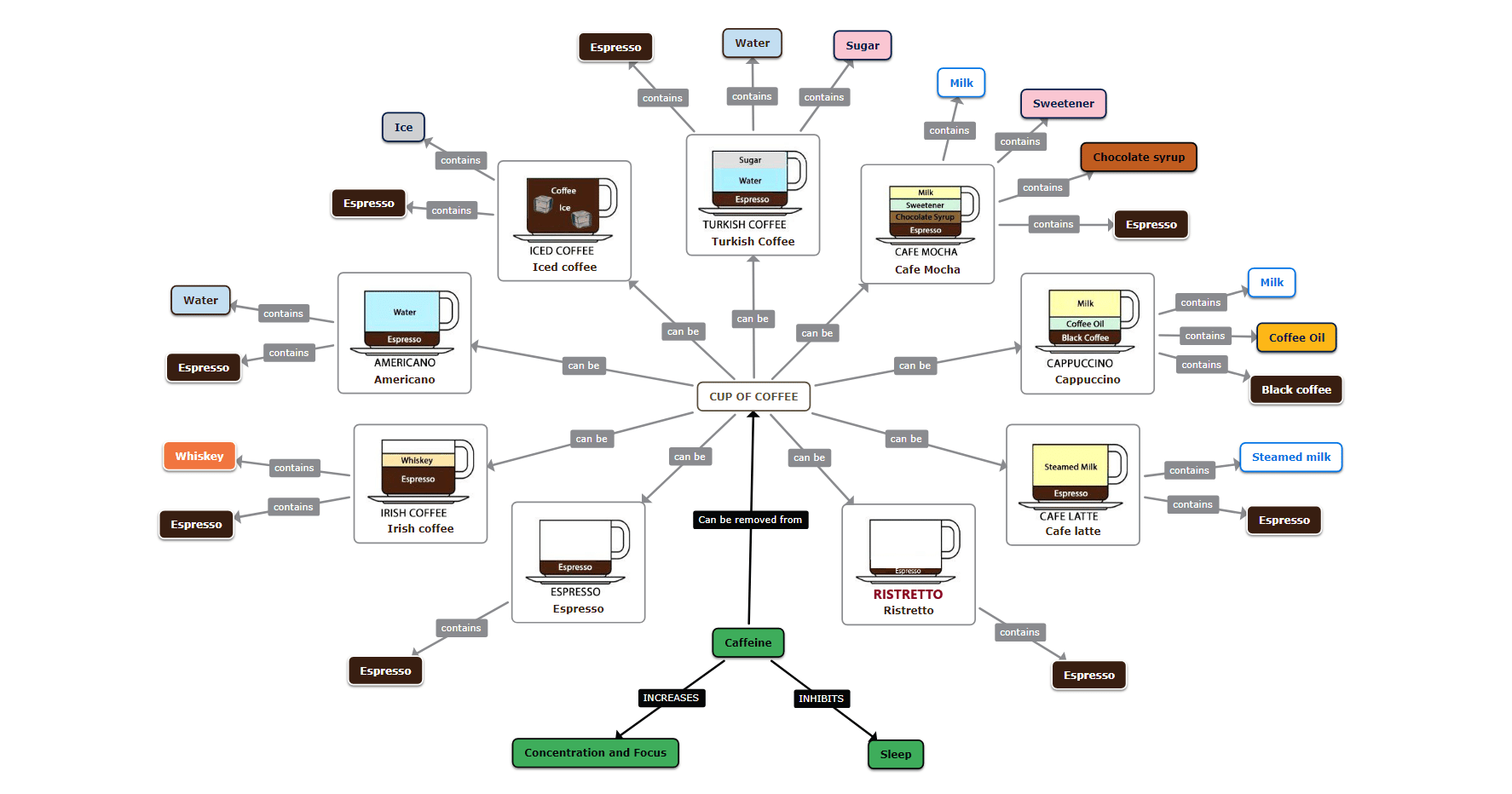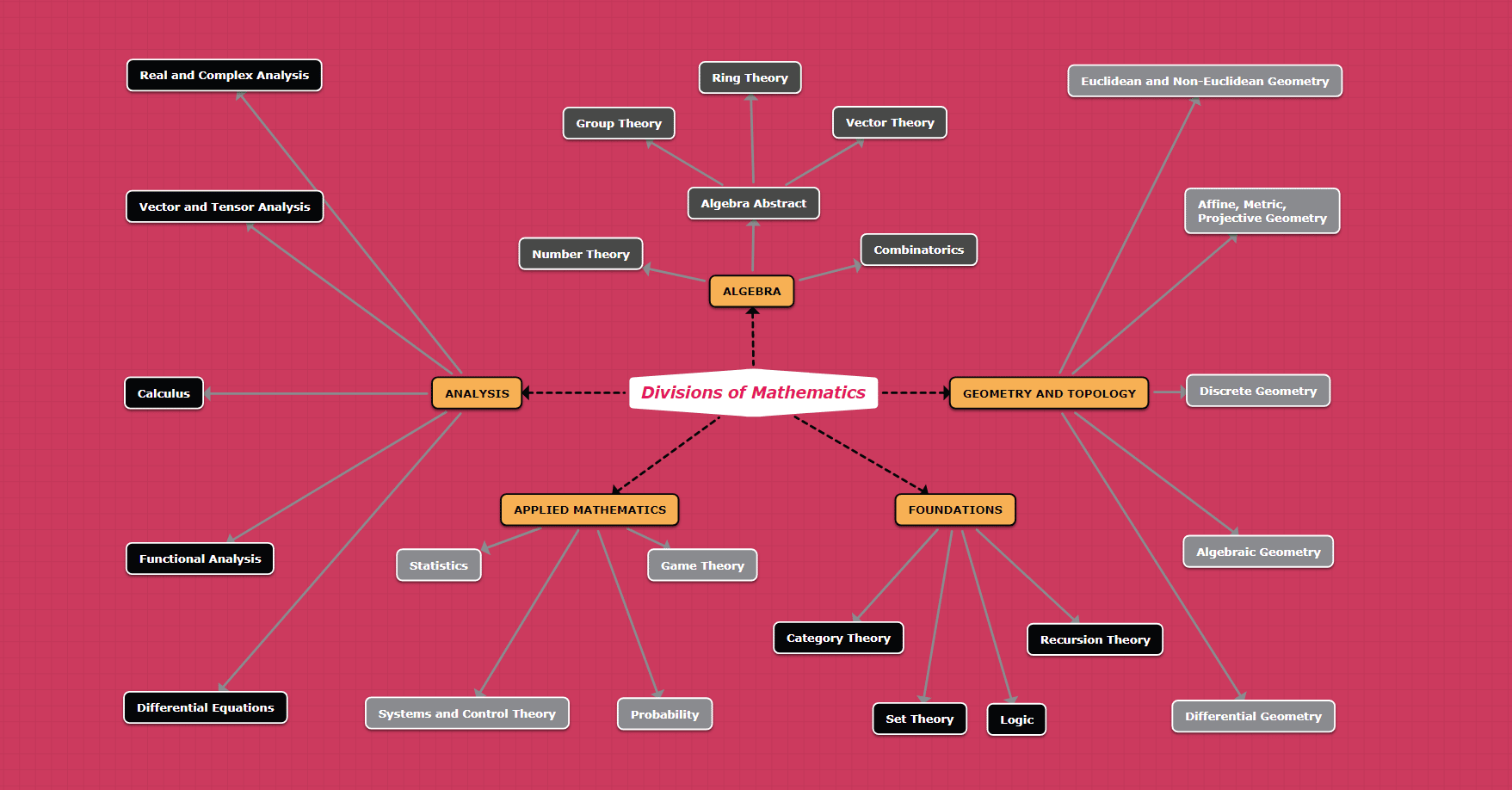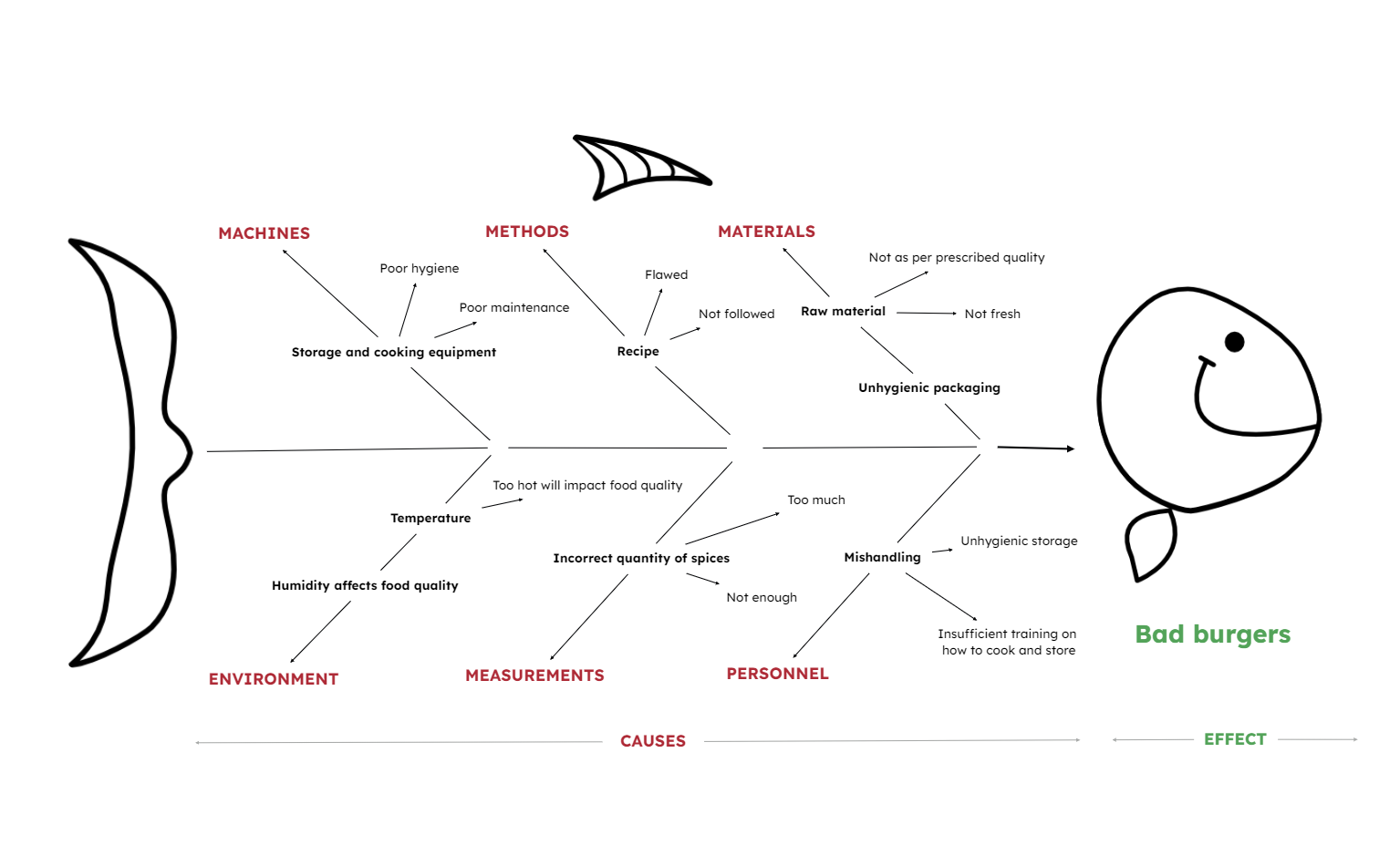Differences between Mind Maps and Concept Maps
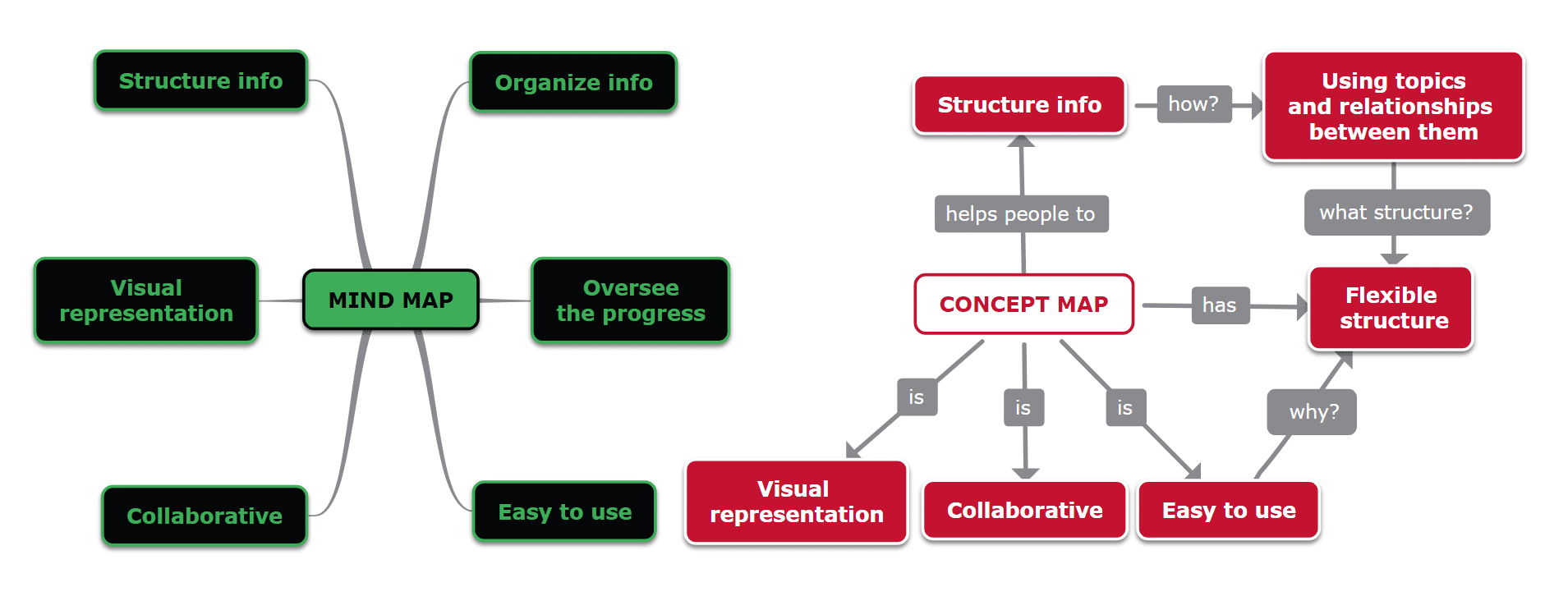
Let’s discuss the differences between concept maps and mind maps. Firstly, in a concept map, the relationships between concepts are explained. There are labeled arrows that link the concepts, and they describe the relationships between ideas.
However, in a mind map, there are connecting lines between related concepts instead of arrows with labels. This way, a concept map offers you the advantage of giving context to all the ideas. Moreover, it becomes easier to understand, especially when there is a complex structure.
Secondly, the two graphic organizers have a flexible structure, but the concept maps have the most flexible layout. You can move the concepts and ideas freely and arrange them anywhere you prefer, and you can have many-to-many relationships. It’s easy to create both types of diagrams using mind map software. On the other hand, a mind map has a more rigid construction.
Let’s take a closer look at concept maps:
Concept Maps: Unveiling the Interconnections of Ideas
Concept maps are visual diagrams that focus on illustrating multiple relationships between ideas and concepts. They provide a visual illustration of knowledge by showcasing how concepts are interconnected. Here are some key aspects of a concept map:
Hierarchical Structure: a concept map has a hierarchical structure with a central concept branching out into sub-concepts. This arrangement helps understand the organization and hierarchy of concepts, enabling a comprehensive overview of the topic. In other words, there are general concepts that branch out to related ideas that represent more specific ideas.
Flexibility and Complexity: a concept map allows a more flexible layout, accommodating various types of connections and associations. They provide the freedom to link concepts in multiple ways, capturing complex relationships and promoting a deeper understanding.
Active Knowledge Construction: Learners actively construct knowledge through the process of creating a concept map. By actively engaging in the mapping process, individuals can enhance their comprehension and retention of information.
Now, let’s explore mind maps:
Mind Maps: Unleashing Creativity and Free-Flowing Associations
What is a mind map? It’s a visual diagram that emphasizes brainstorming and organizing ideas around a central topic, which is represented by a main idea. They are effective for capturing and exploring thoughts and ideas in a non-linear manner. Here are some key features of mind maps:
Radial Structure: Mind maps have a radial structure, with the main ideas radiating outward from a central topic. This structure encourages free-flowing associations and allows for the generation of new ideas and it supports new knowledge creation.
Idea Generation and Organization: Mind maps are often used for idea generation in a brainstorming session, note-taking, and organizing thoughts. They provide a visual overview of a topic, enabling individuals to grasp the main ideas and their relationships quickly.
Stimulating Creative Thinking: Mind maps promote creative thinking and encourage the exploration of connections between various concepts. They provide a platform for capturing diverse ideas and uncovering new insights.
Similarities between Mind Maps and Concept Maps: Enhancing Comprehension and Retention
While mind maps and concept maps differ in their purpose and structure, they also share some common elements.
Both concept maps and mind maps have the basic elements of topic maps: topics, associations, and occurrences.
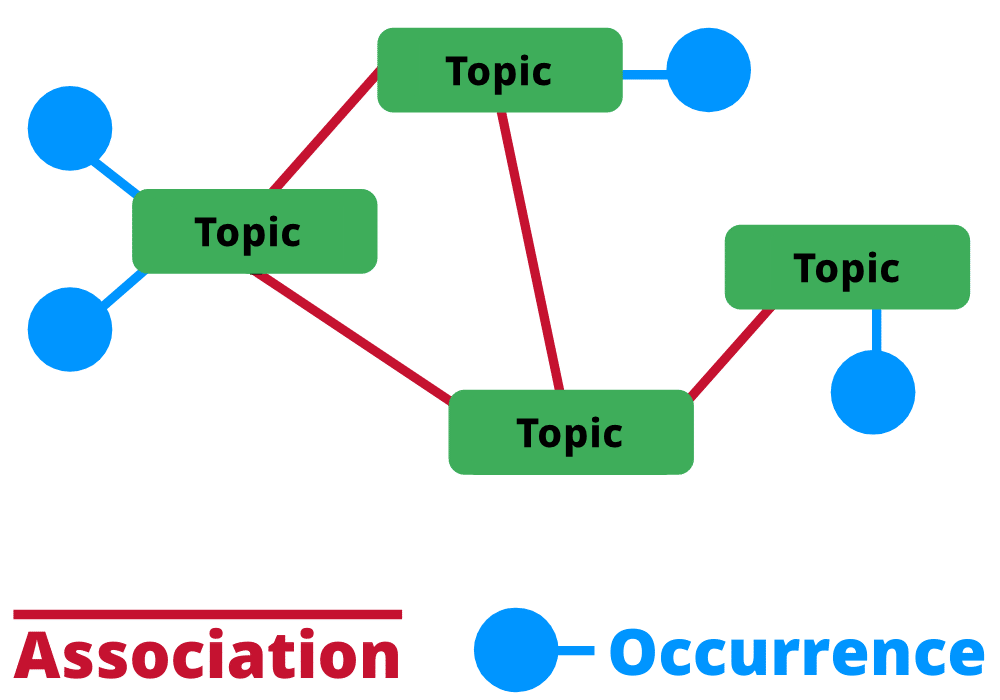
Because concept maps have associations (connecting lines) as labeled arrows, they are more suitable for illustrating complex ideas. It is easier to understand a larger amount of knowledge using concept mapping.
You can depict the processes/elements very simply. This is why they are often used in education. These maps aid meaningful learning, being a great tool that eases the understanding process.
Both a mind map and a concept map are visual tools that enhance comprehension and memory retention. By utilizing visual elements, such as colors, icons, images and symbols, these maps engage the visual learners and make information more memorable.
They employ linking words, visual aids, and hierarchies to make meaningful connections between various ideas. Linking words and phrases like “causes,” “leads to,” “is a type of,” and “is influenced by” establish relationships and clarify connections within the map.
Mind maps and concept maps can be created using dedicated mind map software, such as Mindomo, a versatile concept map maker that offers customizable templates and intuitive features. These tools simplify the process of map creation and provide additional functionalities to enhance the mapping experience.
Read here more about the similarities and differences between concept maps and mind maps.
Key features of a concept map
Many diagrams have a similar look. Even if a lot of them have the basic structure of the topic maps, they are different. There are some key components that make each type special. Here are the elements that make the concept maps remain unique:
Key concepts
Connecting words/ phrases
Structure
The concept map’s structure can be characterized by 3 major elements:
Hierarchical structure – the diagram organizes the elements starting from the most general to more specific ones, like a hierarchy map.
The layout is flexible – one of the differentiating factors from other topic maps is the free form structure. You are able to arrange the diagram from top to bottom exactly how you imagine it, without any kind of limitations. Besides the position of the topics, you can add as many relationships as you want between concepts. There is no restriction that only allows you to connect to ideas.
Propositional structure: two concepts are connected by one linking word (or short linking phrases). Together they become a meaningful statement. Therefore, a map is a visual representation of a set of propositions (meaningful statements) about a central topic. The fact that the linking words are in most cases verbs emphasizes the propositional aspect of this type of diagram.
Focus questions
A concept map usually explains or illustrates a complex matter or subject. Therefore, there must be a focus question that defines the issue that these graphic organizers are trying to solve. It is important to keep in mind this focus question when building concept maps.
Along with the hierarchical structure, the focus question guides you to maintain a certain direction of your thoughts. Hence, you should think about these two features as reference points in the mapping process.
Cross links
Concept Mapping Benefits
Why use concept maps?
The human brain processes visual information better than any other type of information. To be more precise, 90% of the data transmitted to the brain is visual. Consequently, concept mapping is a very efficient technique. Moreover, it is very simple to use, and you can also have fun while creating one. You can use it for different purposes and domains:
Concept Mapping for Education
There are many benefits of using concept maps and mind maps for education, benefiting both educators and learners. Here are some key aspects:
Enhancing Understanding and Knowledge Construction:
A concept map enables learners to organize and understand complex ideas by visually mapping the relationships between key concepts. Education concept maps provide a comprehensive overview of a subject, making it easier to identify connections and comprehend the underlying principles.
There are many concept maps and mind maps for kids that help them understand concepts easily (learn a new language, colors, animals, etc.). Students can create their own concept maps as a means of knowledge construction, encouraging active engagement and deep understanding. By constructing their own concept map, students actively process information, make connections, and develop a more coherent mental representation of the subject matter.
Concept mapping promotes meaningful learning, where learners connect new knowledge to their existing cognitive structures. By relating new concepts to their prior knowledge, learners can better assimilate and integrate new information, fostering a deeper understanding of the topic, which is exactly what meaningful learning involves.
Assessment and Reflection:
Educators can utilize concept maps as valuable assessment tools, evaluating students’ grasp of a subject and identifying areas that require further clarification. By examining the structure and content of students’ concept maps, educators can gain insights into their thought processes and level of understanding.
Concept maps also facilitate reflection and metacognition. Students can analyze and revise their concept maps, identifying gaps in their knowledge base and areas where additional learning is needed. This reflective process enhances self-awareness and promotes self-regulated learning. There are many studies and experiments that prove the effectiveness of concept mapping and mind mapping techniques for education.
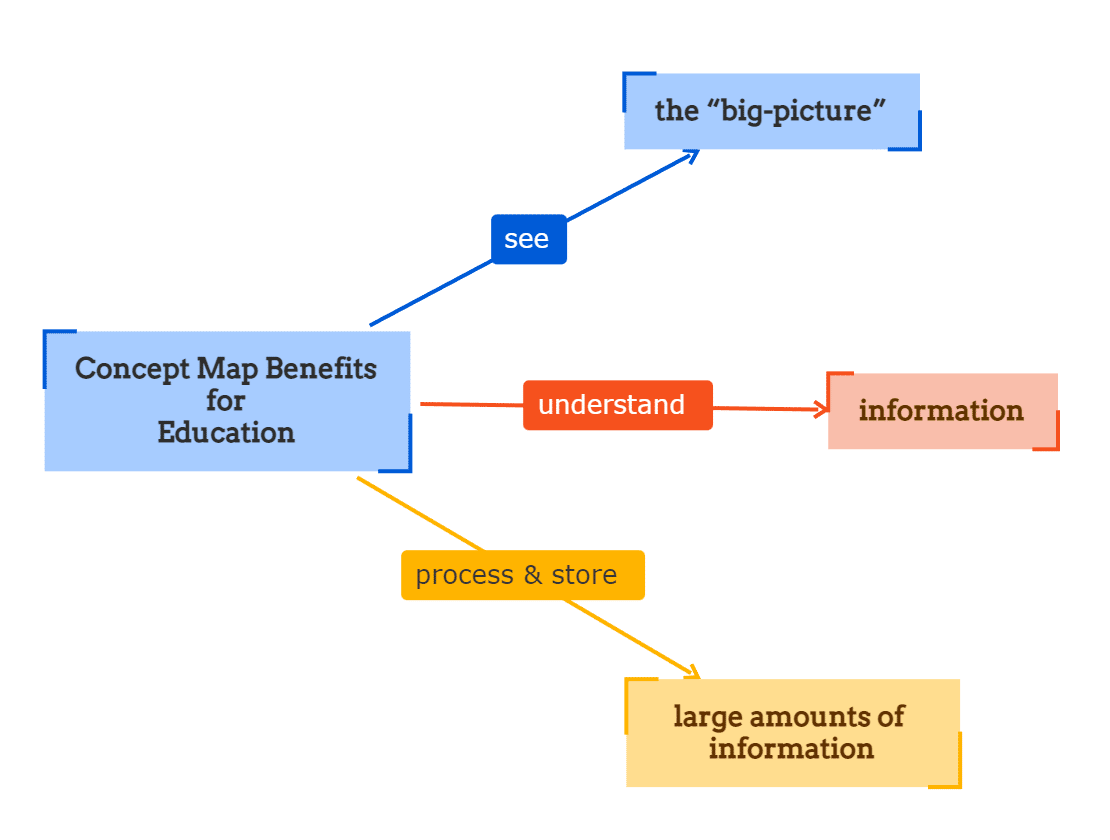
Concept Mapping for Business
Concept mapping is not limited to educational settings; it is also highly beneficial in the business world. Consider the following applications of concept mapping in business:
Knowledge Sharing and Collaboration:
A concept map or a mind map for business serve as an effective facilitative tool for team knowledge sharing, helping team members collaborate, identify relationships, and develop a shared vision. By visually representing ideas and concepts, concept maps foster a common understanding and promote effective communication within teams.
In strategic planning, a concept map assists in mapping out business requirements, cash flows, and interconnections between various elements. They provide a comprehensive overview of the business landscape, helping organizations identify potential opportunities, risks, and dependencies.
Concept maps aid in lexicon development, fostering consistent language and understanding within an organization. By defining and organizing key concepts and their relationships, these diagrams facilitate brain’s ability to communicate efficiently, reducing ambiguity and misunderstandings.
Cross-linking ideas in concept maps can spark innovative thinking and drive problem-solving. By exploring the interrelationships between two concepts (or more), individuals can uncover new insights, identify creative solutions, and drive organizational innovation.
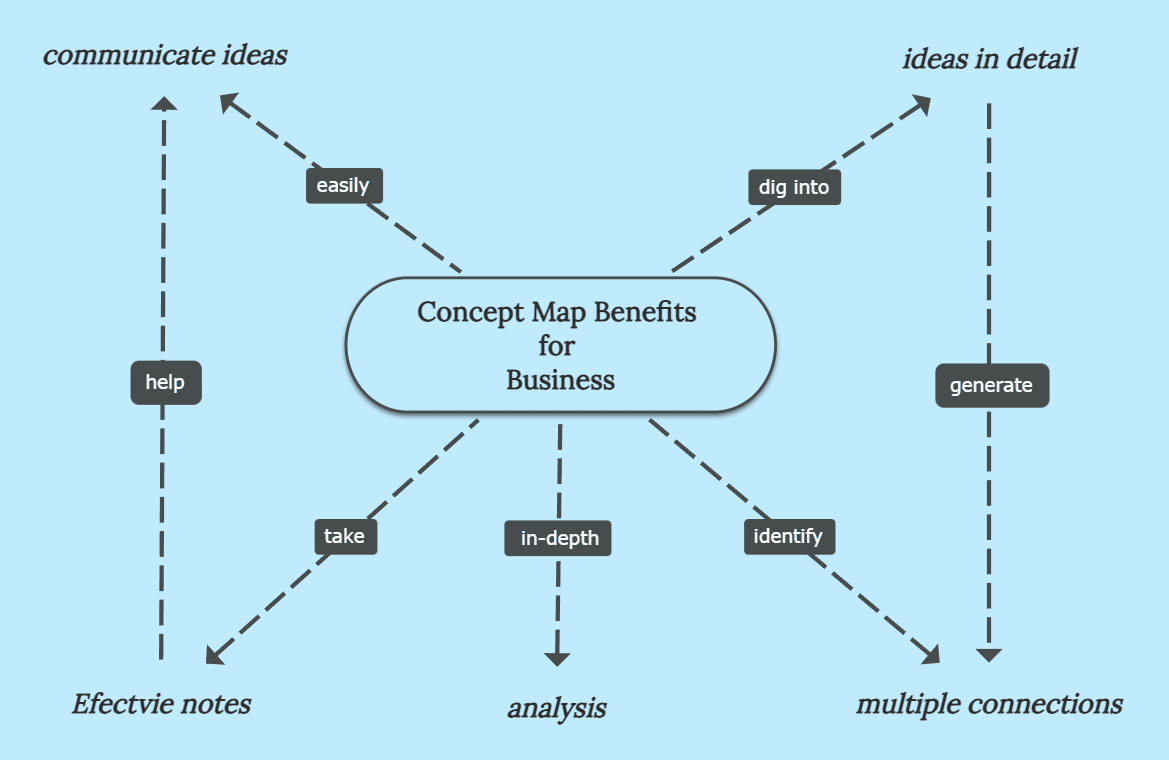
Concept Mapping for Personal Life
Concept mapping can extend beyond formal contexts and be applied to personal life as well. Here are a few examples of using concept mapping in personal life:
Personal Project Management:
Use a concept map to plan and organize personal projects, outlining tasks, milestones, and dependencies. By visually representing project components and their relationships, a concept map provides a clear roadmap for successful project completion.
Create concept maps to explore and visualize connections between different concepts or interests. Whether you are exploring a new hobby, planning a trip, or developing personal goals, concept maps can help you understand the relationships and dependencies between various elements.
These diagrams can help individuals gain a big-picture understanding of complex topics and grasp the interrelationships between different ideas. By mapping out the ideas related to a particular topic, individuals can develop a comprehensive understanding and identify areas for further exploration.
Employ concept maps as brainstorming sessions, allowing you to generate more ideas and think creatively. Concept maps provide a visual canvas for capturing and organizing your thoughts, enabling you to explore connections and uncover new insights that are usually generated internally by the creator.
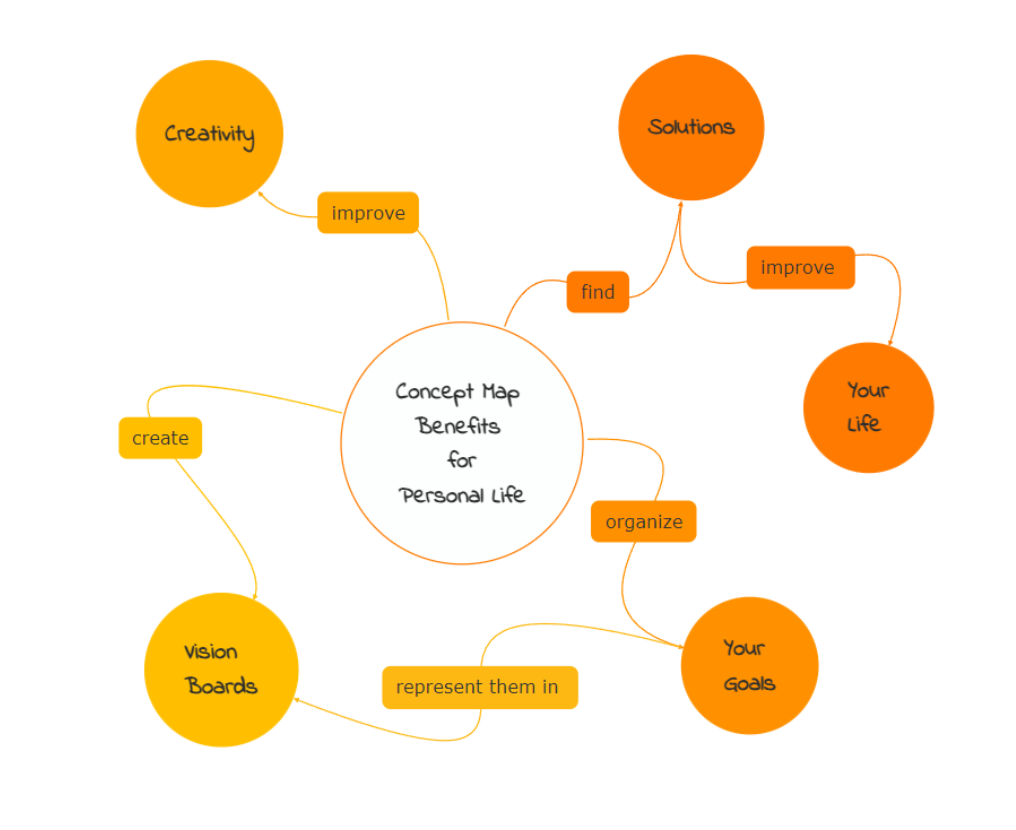
Tips for Creating Effective Concept Maps
To create effective concept maps, consider the following tips:
Start with a clear focus question: Define a central question or topic that will guide the development of your concept map. This focus question will help you stay focused and ensure that your map remains coherent.
Organize concepts hierarchically: Begin with the main concept and branch out to subconcepts. Arrange the concepts in a logical order to showcase their relationships effectively.
Use linking words and phrases: Linking words such as “causes,” “leads to,” “is a type of,” and “is influenced by” help establish connections between concepts. These words enhance the clarity of relationships within your concept map creating the propositional structure which is specific to these diagrams.
Incorporate visuals and icons: Visual components like icons, symbols, and images can add visual appeal and aid in memory retention. Choose relevant visuals that represent the essence of each concept.
Use colors and formatting: Employ colors and formatting techniques to visually differentiate concepts, branches, and relationships. Consistent color schemes and font styles improve readability and enhance the overall aesthetics of your concept map.
Review and revise: Periodically review your concept map to ensure accuracy, coherence, and clarity. Revise and refine the map as needed to maintain its effectiveness and relevance.
Concept Maps for Enhanced Learning and Communication
Concept maps provide a versatile and powerful way to organize and represent knowledge visually. They offer a flexible layout, allowing for complex ideas and relationships to be effectively communicated. Whether you’re a student, professional, or simply someone seeking to enhance your understanding, concept maps can be invaluable tools.
With their ability to capture the big picture, promote meaningful learning, and stimulate creativity, concept maps have become an essential part of various fields, including education, business, and personal development. Think about these diagrams like advance organizers and use them as facilitative tools for any field mentioned above.
Concept map examples
Plant elements
This example illustrates that the concept map is a diagram that can be used by anyone, from little kids to grown-ups.
This diagram represents the structure of a plant expressed in a simple and very understandable way for children. It shows the relationships between each element with the plant itself and with external elements.
All the school subjects can use concept mapping to simplify the knowledge and make it easily understandable for the students.
There are different colors and shapes used for each category of elements.
For example, all the plant elements have an orange cloud shape and capital letters and all the external elements have a white rectangle and small letters. Some of the topics have suggestive icons that contribute to the visual impact.
Enzymes explained
In comparison with the previous example, this enzyme concept map also shows a topic that can be part of a school class. But the difference is that this one is more suitable for bigger students.
The layout is simple, making it simple to follow. It doesn’t refer to the types of enzymes or the component elements like it was in the previous example, it is rather focused on the most important things to know about the central idea.
It illustrates what is made out of, the behavior in the presence of external factors and other characteristics.
Risk management
The risk management concept map is a very powerful tool for business people. The risk is very common for a business and a business person is aware of this threat.
This concept map explains this concept and it acts like a small guide. It offers multiple types of information.
For example, the steps of the whole process, where it can happen, and what tools you need.
This layout offers an overview of the matter and also helps the reader to understand it better.
Types of coffee
As it was mentioned before, the concept maps are not just a tool for work or education.
They can be a great instrument in your personal life, finding uses in everyday life.
This example represents many types of coffee, their ingredients, and the recipe for each one.
It can have an informational purpose, but it can inspire you to try a different type of coffee at the same time.
Math divisions
There are very complex subjects in school, for instance, mathematics.
Everybody knows that it’s related to numbers and calculations, but this is just a small part of it. In this concept map, it is divided into all categories.
The main divisions are written in orange rectangles. All these divisions are explained, so the reader can understand what each division does and how all of them compose the big science called math.
Fishbone diagram
The fishbone diagram can be a different type of visual representation, but it has a concept map structure.
If we look closely, it is actually a concept map that is divided into 2 big segments. On the left side, where there is the body and the tail of the fish we have the cause.
These causes lead to the head of the fish, which is the effect. The effect represents the central topic of the matter. The body simply divides all the causes by categories.
Frequently asked questions about Concept Maps:
Q: Can concept maps be created manually, or do I need specialized software?
A: Concept maps can be created manually using traditional pen and paper or digitally using dedicated concept mapping software. Software tools like Mindomo offer customizable templates and intuitive features that simplify the process and provide additional functionalities.
Q: How can concept maps enhance memory retention?
A: Concept maps engage the visual learning style by utilizing visual elements such as colors, icons, and symbols. This visual representation makes information more memorable and aids in memory retention.
Q: Are there recommended software tools for creating concept maps?
A: Yes, there are several recommended software tools for creating concept maps. Some popular options include Mindomo, Coggle, XMind, and Lucidchart. These tools offer various features and templates to support the creation of concept maps.
Q: Can concept maps be used for collaborative work?
A: Absolutely. Concept maps can be created collaboratively, allowing team members to contribute their ideas and insights. Software tools often provide real-time collaboration features that enable team members to work together on a concept map simultaneously.
Q: How can concept maps benefit educators?
A: Concept maps serve as valuable assessment tools for educators, allowing them to evaluate students’ understanding of a subject and identify areas that need further clarification. Concept maps also promote active engagement, deep understanding, and meaningful learning among students.
Q: Can concept maps be used for personal organization and planning?
A: Yes, concept maps can be applied to personal life for various purposes. They can help in personal project management, exploring connections between different interests, gaining a comprehensive understanding of complex topics, and facilitating brainstorming and creative thinking.
